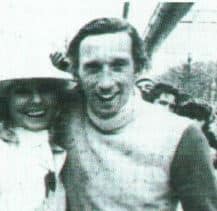The thing about Sandy was that everyone – absolutely everyone liked him. He was kind, honourable, generous and, perhaps above all, he was fun to be with.

Everything he attempted in life was tackled wholeheartedly and with passion, particularly his three major loves: his family, his racing and his Regiment.
Alexander James Cramsie joined the Queen’s Royal Irish Hussars in Aden in 1961, moving with the regiment to Malaya and Singapore the following year.
On 12 December 1962 he and two Ferret Scout Cars manned by members of his troop were flown by Beverley aircraft to Seria, the centre of Brunei’s oil drilling operations, to help the Queen’s Own Highlanders secure the town against a rebel threat.
In the end, all was well and Sandy and his men were awarded the last clasp of the old General Service Medal. Further adventures followed until the regiment moved to Wolfenbuttel close to the then East German border at the end of 1964.
By this time Cramsie had been posted to be ADC to General Monkey Blacker, the General Officer Commanding the 3rd Division at his headquarters at Bulford on Salisbury Plain. Sandy and his General knew each other well from their time with the Staff College and Sandhurst Draghounds some five years earlier and it was here that he developed his passion for point-to-pointing and national hunt racing.
It was at this time too that he married Bridget and it would be difficult to imagine a more devoted pair than these two over the next 43 years.
Sandy’s other military appointments included being adjutant of the North Irish Horse Squadron of the Royal Yeomanry – a job which enabled him to live at home in O’Harabrook near Ballymoney.
He commanded ‘B’ Squadron of the Irish Hussars in Paderborn and during an emergency United Nations tour in Cyprus. He and Bridget liked Cyprus so much that he was soon to return there as a staff officer – thereby providing a much sought-after holiday home for their friends.
He returned to the Irish Hussars as regimental second-in-command at Tidworth in 1980 where he loyally rode the commanding officer’s rather slow and elderly hunter in two point-to-points, risking his neck far more seriously than anything encountered in his Army career. At a far more elevated level, he won the Grand Military Steeplechase twice and was also particularly proud of winning The Sun newspaper’s Page Three Race at Aintree in 1978 on a horse trained by Peter Bailey, another Irish Hussar.
Sandy was a member of the Grand Military Committee for a quarter of a century and a steward of the military races at Sandown Park. He was also a distinguished steward of race courses in Ireland where he became much respected among the most critical of racing communities.
He ended his military career by commanding the Queen’s Own Yeomanry. His headquarters was situated in Northumberland, the county of his birth, and he could not have been happier or more fulfilled. He described it often as the best job in the Army and it is equally true that his yeomen (of whatever rank) accounted themselves lucky to have such a caring and proficient commanding officer.
In retirement at O’Harabrook, he worked tirelessly on the house, land and holiday cottages – always closely supported by Bridget – as well as for the Army Benevolent Fund and a host of other charities.
He became a Deputy Lieutenant for County Antrim and Honorary Colonel of 40 (Ulster) Signal Regiment (Volunteers).
His assiduous presidency of two of the Queen’s Royal Hussars Regimental Association Troops was much appreciated by retired Irish Hussars of all ranks, and the turnout at his funeral where the congregation spilt out into the churchyard (and later into the bars of Ballymoney where his health was drunk enthusiastically) was a measure of the regard in which he was held.
We shall always remember the officer who, as more than one trooper was heard to remark, was so physically slight a figure that ‘ if you turned him sideways, he’d disappear.’


